
Concept explainers
(a)
Interpretation:
The structure for the given molecule is to be drawn.
Concept introduction:
When assigning priorities to substituents, the atom having the greater
Answer to Problem C.31P
The structure of

Explanation of Solution
The given name is:
In this compound, the root is butane. The longest continuous carbon chain contains four carbon atoms. A chlorine and a fluorine atom are attached to the C1 carbon atom of the root. The structure of the molecule without considering its stereochemistry is:
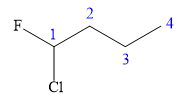
There is one chiral carbon at C1 in the above molecule. The required configuration at the chiral carbon atom is R.
At C1 carbon atom, the four substituents are:
Applying the first tiebreaker,
In the given structure, the top-three priority substituents are arranged in a clockwise manner.
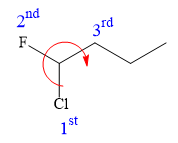
Thus, in order to maintain this arrangement at the C1 carbon atom, the fourth priority substituent must be attached by a dash bond and the Cl atom must be attached by a wedge bond. Therefore, the correct structure for

The structure for the given name is drawn as shown above.
(b)
Interpretation:
The structure for the given molecule is to be drawn.
Concept introduction:
When assigning priorities to substituents, the atom having the greater atomic number has a higher priority. In the case of comparison between isotopes, the one having the greater atomic mass gets the higher priority. When the fourth priority substituent is pointing away (it is attached by a dash bond) and the first, second and third priority substituents are arranged clockwise, the configuration is R. When the fourth priority substituent is pointing away (it is attached by a dash bond) and the first, second and third priority substituents are arranged counterclockwise, the configuration is S. If the fourth priority substituent is attached by a wedge bond, then the clockwise or counterclockwise arrangement of the first, second and third priority substituents is determined and that arrangement is reversed before assigning R or S. If the fourth priority substituent is in the plane of the page, then it is switched with the substituent that points away. Then the clockwise or counterclockwise arrangement of the first, second and third priority substituents is determined and that arrangement is reversed before assigning R or S. When writing the IUPAC name, the R or S designation is written in parenthesis for each asymmetric carbon atom and hyphens are used to separate those designations from the rest of the IUPAC name.
Answer to Problem C.31P
The structure of

Explanation of Solution
The given name is:
In this compound, the root is pentane. The longest continuous carbon chain should have five carbon atoms. One chlorine atom is attached to the C2 carbon atom of the root.
The structure of the molecule without considering its stereochemistry is:
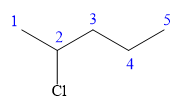
There is one chiral carbon at C2 in the above molecule. The required configuration at the chiral carbon atom is S.
At C2 carbon atom, the four substituents are:
Applying the first tiebreaker,
In the given structure, the top-three priority substituents are arranged in a counterclockwise manner.
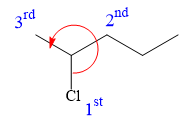
Thus, in order to maintain this arrangement of substituents at the C2 carbon atom, the fourth-priority substituent must be attached by a wedge bond and the chlorine atom must be attached by a dash bond. Therefore, the correct structure for

The structure for the given name is drawn as shown above.
(c)
Interpretation:
The structure for the given molecule is to be drawn.
Concept introduction:
When assigning priorities to substituents, the atom having the greater atomic number has a higher priority. In the case of comparison between isotopes, the one having the greater atomic mass gets the higher priority.
When the fourth priority substituent is pointing away (it is attached by a dash bond) and the first, second and third priority substituents are arranged clockwise, the configuration is R.
When the fourth priority substituent is pointing away (it is attached by a dash bond) and the first, second and third priority substituents are arranged counterclockwise, the configuration is S.
If the fourth priority substituent is attached by a wedge bond, then the clockwise or counterclockwise arrangement of the first, second and third priority substituents is determined and that arrangement is reversed before assigning R or S.
If the fourth priority substituent is in the plane of the page, then it is switched with the substituent that points away. Then the clockwise or counterclockwise arrangement of the first, second and third priority substituents is determined and that arrangement is reversed before assigning R or S. When writing the IPUAC name, the R or S designation is written in parenthesis for each asymmetric carbon atom and hyphens are used to separate those designations from the rest of the IUPAC name.
Answer to Problem C.31P
The structure of

Explanation of Solution
The given name is:
In this compound, the root is pentane. The longest continuous carbon chain should have five carbon atoms. One chlorine atom and a methoxy group are attached to the C2 carbon atom of the root. The structure of the molecule without considering its stereochemistry is:
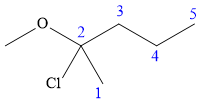
There is one chiral carbon at C2 in the above molecule. The required configuration at the chiral carbon atom is R.
At C2 carbon atom, the four substituents are:
Applying the first tiebreaker,
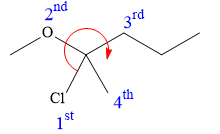
Thus, in order to maintain this clockwise arrangement of substituents at C2 carbon atom, the fourth-priority substituent must be attached by a dash bond. Therefore, the correct structure for

The structure for the given name is drawn as shown above.
(d)
Interpretation:
The structure for the given molecule is to be drawn.
Concept introduction:
When assigning priorities to substituents, the atom having the greater atomic number has a higher priority. In the case of comparison between isotopes, the one having the greater atomic mass gets the higher priority. When the fourth priority substituent is pointing away (it is attached by a dash bond) and the first, second and third priority substituents are arranged clockwise, the configuration is R. When the fourth priority substituent is pointing away (it is attached by a dash bond) and the first, second and third priority substituents are arranged counterclockwise, the configuration is S. If the fourth priority substituent is attached by a wedge bond, then the clockwise or counterclockwise arrangement of the first, second and third priority substituents is determined and that arrangement is reversed before assigning R or S. If the fourth priority substituent is in the plane of the page, then it is switched with the substituent that points away. Then the clockwise or counterclockwise arrangement of the first, second and third priority substituents is determined and that arrangement is reversed before assigning R or S. When writing the IPUAC name, the R or S designation is written in parenthesis for each asymmetric carbon atom and hyphens are used to separate those designations from the rest of the IUPAC name.
Answer to Problem C.31P
The structure of
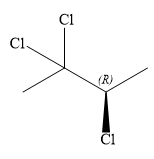
Explanation of Solution
The given name is:
In this compound, the root is butane. The longest continuous carbon chain should have four carbon atoms. Three chlorine atoms are attached to C2, C2 and C3 carbon atoms of the root. The structure of the molecule without considering its stereochemistry is:
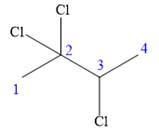
There is one chiral carbon at C3 in the above molecule. The required configuration at the chiral carbon atom is R.
At C3 carbon atom, the four substituents are:
Applying the first tiebreaker,
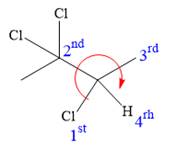
Thus, in order to maintain this clockwise arrangement of substituents at the C3 carbon atom, the fourth-priority substituent must be attached by a dash bond and the chlorine atom must be attached by a wedge bond. Therefore, the correct structure for

The structure for the given name is drawn as shown above.
(e)
Interpretation:
The structure for the given molecule is to be drawn.
Concept introduction:
When assigning priorities to substituents, the atom having the greater atomic number has a higher priority. In the case of comparison between isotopes, the one having the greater atomic mass gets the higher priority. When the fourth priority substituent is pointing away (it is attached by a dash bond) and the first, second and third priority substituents are arranged clockwise, the configuration is R. When the fourth priority substituent is pointing away (it is attached by a dash bond) and the first, second and third priority substituents are arranged counterclockwise, the configuration is S. If the fourth priority substituent is attached by a wedge bond, then the clockwise or counterclockwise arrangement of the first, second and third priority substituents is determined and that arrangement is reversed before assigning R or S. If the fourth priority substituent is in the plane of the page, then it is switched with the substituent that points away. Then the clockwise or counterclockwise arrangement of the first, second and third priority substituents is determined and that arrangement is reversed before assigning R or S. When writing the IPUAC name, the R or S designation is written in parenthesis for each asymmetric carbon atom and hyphens are used to separate those designations from the rest of the IUPAC name.
Answer to Problem C.31P
The structure of
Explanation of Solution
The given name is:
In this compound, the root is hexane. The longest continuous carbon chain should have six carbon atoms. One methyl group is attached to C3 carbon atoms of the root.
The structure of the molecule without considering its stereochemistry is:
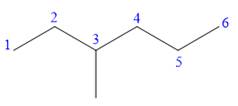
There is one chiral carbon at C3 in the above molecule. The required configuration at the chiral carbon atom is S.
At C3 carbon atom, the four substituents are:
Applying the second tiebreaker, the
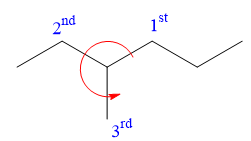
Thus, in order to maintain this arrangement of substituents at the C3 carbon atom, the third-priority substituent must be attached by a wedge bond. Therefore, the correct structure for
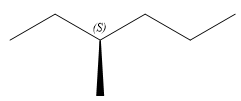
The structure for the given name is drawn as shown above.
(f)
Interpretation:
The structure for the given molecule is to be drawn.
Concept introduction:
When assigning priorities to substituents, the atom having the greater atomic number has a higher priority. In the case of comparison between isotopes, the one having the greater atomic mass gets the higher priority. When the fourth priority substituent is pointing away (it is attached by a dash bond) and the first, second and third priority substituents are arranged clockwise, the configuration is R. When the fourth priority substituent is pointing away (it is attached by a dash bond) and the first, second and third priority substituents are arranged counterclockwise, the configuration is S. If the fourth priority substituent is attached by a wedge bond, then the clockwise or counterclockwise arrangement of the first, second and third priority substituents is determined and that arrangement is reversed before assigning R or S. If the fourth priority substituent is in the plane of the page, then it is switched with the substituent that points away. Then the clockwise or counterclockwise arrangement of the first, second and third priority substituents is determined and that arrangement is reversed before assigning R or S. When writing the IPUAC name, the R or S designation is written in parenthesis for each asymmetric carbon atom and hyphens are used to separate those designations from the rest of the IUPAC name.
Answer to Problem C.31P
The structure of

Explanation of Solution
The given name is:
In this compound, the root is pentane. The longest continuous carbon chain has five carbon atoms. A bromine atom and a nitro group are attached to C1 and C2 carbon atoms of the root. The structure of the molecule without considering its stereochemistry is:

There is only one chiral center at C2 carbon atom in the above molecule.
The required configuration at the chiral center is S.
At C2 carbon atom, the four substituents are:
Applying the first tiebreaker,
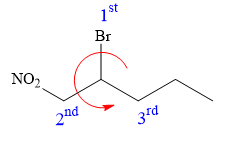
Thus, in order to maintain this arrangement of substituents at the C2 carbon atom, the fourth-priority substituent must be attached by a wedge bond and the bromine atom must be attached as shown below:

The structure for the given name is drawn as shown above.
Want to see more full solutions like this?
Chapter C Solutions
ORGANIC CHEMISTRY PRINCIPLES & MECHANISM
- How does the square root mean square velocity of gas molecules vary with temperature? Illustrate this relationship by plotting the square root mean square velocity of N2 molecules as a function of temperature from T=100 K to T=300 K.arrow_forwardDraw product B, indicating what type of reaction occurs. F3C CF3 NH2 Me O .N. + B OMearrow_forwardBenzimidazole E. State its formula. sState the differences in the formula with other benzimidazoles.arrow_forward
- Draw product A, indicating what type of reaction occurs. F3C CN CF3 K2CO3, DMSO, H₂O2 Aarrow_forward19) Which metal is most commonly used in galvanization to protect steel structures from oxidation? Lead a. b. Tin C. Nickel d. Zinc 20) The following molecule is an example of a: R₁ R2- -N-R3 a. Secondary amine b. Secondary amide c. Tertiary amine d. Tertiary amidearrow_forwardpls helparrow_forward
- pls helparrow_forward35) Complete the following equation by drawing the line the structure of the products that are formed. Please note that in some cases more than one product is possible. You must draw all possible products to recive full marks! a. ethanol + 2-propanol + H2SO4 → b. OH conc. H2SO4 CH2 H3C CH + K2Cr2O7 C. d. H3C A pressure CH3 + H2 CH Pt catalystarrow_forward21) The rate of reaction depends upon: a. the concentration and nature of reactants b. the temperature of the reaction C. whether or not a catalyst was used d. all of the above 22) A Maxwell-Boltzmann curve shows the distribution of molecular energies in a reaction system. When the temperature in this system is increased, the peak is a. higher and further to the right. b. higher and further to the left. c. lower and further to the right. d. lower and further to the left. 23) Which of the following correctly describes the reaction represented by the reaction below? CaCO3 (s) + energy → CaO (s) + CO2 (g) a. It is exothermic and the potential energy is greater in the reactants than the products. b. c. It is exothermic and the potential energy is greater in the products than the reactants. It is endothermic and the potential energy is greater in the products than the reactants. d. It is endothermic and the potential energy is equal for the products and reactants.arrow_forward
 ChemistryChemistryISBN:9781305957404Author:Steven S. Zumdahl, Susan A. Zumdahl, Donald J. DeCostePublisher:Cengage Learning
ChemistryChemistryISBN:9781305957404Author:Steven S. Zumdahl, Susan A. Zumdahl, Donald J. DeCostePublisher:Cengage Learning ChemistryChemistryISBN:9781259911156Author:Raymond Chang Dr., Jason Overby ProfessorPublisher:McGraw-Hill Education
ChemistryChemistryISBN:9781259911156Author:Raymond Chang Dr., Jason Overby ProfessorPublisher:McGraw-Hill Education Principles of Instrumental AnalysisChemistryISBN:9781305577213Author:Douglas A. Skoog, F. James Holler, Stanley R. CrouchPublisher:Cengage Learning
Principles of Instrumental AnalysisChemistryISBN:9781305577213Author:Douglas A. Skoog, F. James Holler, Stanley R. CrouchPublisher:Cengage Learning Organic ChemistryChemistryISBN:9780078021558Author:Janice Gorzynski Smith Dr.Publisher:McGraw-Hill Education
Organic ChemistryChemistryISBN:9780078021558Author:Janice Gorzynski Smith Dr.Publisher:McGraw-Hill Education Chemistry: Principles and ReactionsChemistryISBN:9781305079373Author:William L. Masterton, Cecile N. HurleyPublisher:Cengage Learning
Chemistry: Principles and ReactionsChemistryISBN:9781305079373Author:William L. Masterton, Cecile N. HurleyPublisher:Cengage Learning Elementary Principles of Chemical Processes, Bind...ChemistryISBN:9781118431221Author:Richard M. Felder, Ronald W. Rousseau, Lisa G. BullardPublisher:WILEY
Elementary Principles of Chemical Processes, Bind...ChemistryISBN:9781118431221Author:Richard M. Felder, Ronald W. Rousseau, Lisa G. BullardPublisher:WILEY





